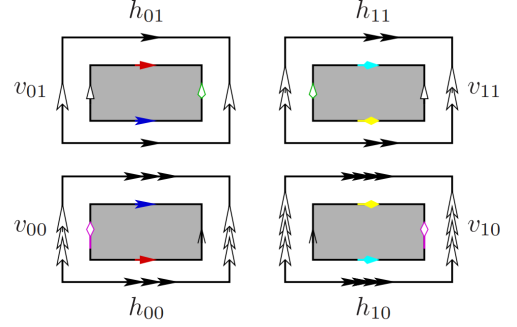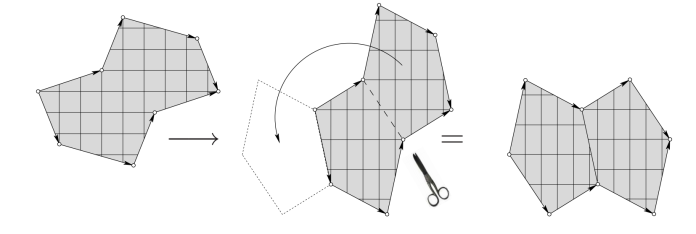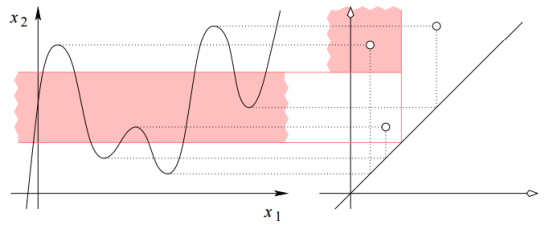Knots (links) are embeddings of the circle (some finite number of circles) into the 3-sphere, modulo ambient isotopy. Knot theory is thus the study of the essentially different ways we can embed a circle into a 3-sphere—a kind of deformation theory for such maps, if you will. From this perspective, it is perhaps not too surprising that knot theory has developed connections to many areas of pure and applied mathematics.
For example, knot complements and Dehn surgery are important sources of examples for 3-manifolds. Knot complements are intimately related to knots themselves, by the Gordon-Luecke theorem; Dehn surgery not only has the virtue of being explicitly computable, it is also a fairly generic source of 3-manifolds, by the Lickorish-Wallace theorem.
Or, for example, knot theory shows up in physics in various ways. Indeed, knot theory and physics tangled from fairly early on: most prominently, Lord Kelvin’s theory of “vortex atoms” posited that atoms can be modeled as knots of aether. While this turned out to be wrong from a physical standpoint, it did inspire Tait to start classifying knots and spur the mathematical development of knot theory; and it may yet find a spiritual successor in the “anyons” of topological quantum computing.
Yet another early connection can be seen in the linking number, one of the first knot (or link) invariants, which Gauss came up in his study of a question from electrodynamics: how much work is done on a magnetic pole moving along a closed loop in the presence of a loop of current? Using the Ampere and Biot-Savart law, he found the answer could be described in terms of how many times one of these loops winds around the other, or in other words the linking number of the two loops (see e.g. pp. 2-4 here.)
Knot invariants
More generally, knot (or link) invariants are mathematical objects—numbers, polynomials, homology groups, whatever have you—attached to knots (or links—I’ll stop writing this, but you should imagine inserted after each instance of “knot” below.) Equivalent (i.e. ambient-isotopic) knots should be assigned the same value—hence the name “invariant”—although certain pairs of non-equivalent knots may also be assigned equal values.
These are useful, primarily, for distinguishing knots—for providing a verifiable certificate that two knots are indeed inequivalent, as it were.
It is straightforward enough, in principle, to prove that two knots are equivalent: one simply exhibits an ambient isotopy taking one to the other. Indeed, this ambient isotopy can always be described within an explicitly-described standard combinatorial model—using a class of standard local “moves”, the Reidemeister moves, on knot diagrams, i.e. projections of the knot to a plane, decorated with additional information about which strand crosses “over” the other at each double point.
(Completely tangential aside: knot diagrams can be an endless source of combinatorial fun—see e.g. this REU paper on games on shadows of knots.)
It is rather harder to prove that two knots are inequivalent this way: failure to exhibit a suitable sequence of Reidemeister moves doesn’t prove that an ambient isotopy can’t exist—perhaps with more ingenuity one could in fact find the requisite Reidemeister moves? Hence the utility of knot invariants: if we can show that two knots take on different values for a certain knot invariant, that definitively shows that they are inequivalent.
Some examples of knot invariants include the crossing number—which can be defined as the minimum number of crossings (double points) which any knot diagram of a given knot must have—, the unknotting number—which can be defined as the least number of times one needs to pass a knot through itself (or, equivalently, the least number of crossings that need to be switched) to get to an unknot—, and the Seifert genus—the minimal genus of any connected oriented surface whose boundary is the knot.
These invariants are intuitive and natural measures of the “complexity” of a knot, but are notoriously hard to compute and study. For instance, it is conjectured, but still not known, that the crossing number is additive under taking connect-sums, and it took a surprising amount of work (an Inventiones paper!) to show that composite knots have unknotting number at least 2. In some sense, an understanding of these invariants can be seen as a primary aim, rather than a tool, of knot theory.
More computable, but in some ways less intuitive and more mysterious, are invariants of a more algebraic nature: things such as the signature or Arf invariant coming from naturally-associated quadratic forms, or various knot polynomials which package this and other knot data into their coefficients. The theory behind and extending from these knot polynomials, in particular has driven much of modern knot theory, and we touch on some of these developments below.
The turn to combinatorics (and algebra)
Starting with Conway’s work on the Alexander polynomial in the 1960s, it has been realized that many of these polynomials can be defined and computed combinatorially, using skein relations; building on this, and introducing language and ideas from statistical mechanics, Kauffman formulated state-sum models for computing the Alexander and Jones polynomials in the 1980s.
This was not the first time physics had popped up here, either: models from statistical mechanics motivated the von Neumann algebras and braid representations which were originally used to define the Jones polynomial. This was in many ways a pivotal development in the theory: to borrow The Unapologetic Mathematician’s words:
Jones was studying a certain kind of algebra when he realized that the defining relations for these algebras were very much like those of the braid groups. In fact, he was quickly able to use this similarity to assign a Laurent polynomial … to every knot diagram that didn’t change when two diagrams differed by a Reidemeister move. That is, it was a new invariant of knots.
The Jones polynomial came out of nowhere, from the perspective of the day’s knot theorists. And it set the whole field on its ear. From my perspective looking back, there’s a huge schism in knot theory between those who primarily study the geometry and the “classical topology” of the situation and those who primarily study the algebra, combinatorics, and the rising field of “quantum topology”. To be sure there are bridges between the two … But the upshot was that the Jones polynomial showed a whole new way of looking at knots and invariants.
Extending the skein relation approach to build invariants on a larger class of knots with singular points leads us to the theory of the much more powerful, and possibly fundamental finite-type (Vassiliev) invariants, which has subsequently been studied using such tools as chord diagrams and the Kontsevich integral.
Knot homology theories
Another, related direction in which knot polynomials have taken off is towards homological algebra, in a development sometimes described as “categorification”. Categorifying a knot polynomial involves building a homology whose Euler characteristic—in an appropriate sense, involving some sort of alternating sum of data from the homology groups—recovers the knot polynomial.
The homology groups of a topological space contain all the information carried by the Euler characteristic, and then some; in some sense, they are the more fundamental invariant, of which the Euler characteristic is just a “decategorified shadow”. Similarly, a knot homology theory should be, in principle at least, more powerful and fundamental than the polynomial it categorifies .
The two main (flavors of) knot homology are Khovanov homology and knot Floer homology. Khovanov homology, developed in the late 1990s by Mikhail Khovanov, is related to ideas in representation theory, and categorifies the Jones polynomial. Knot Floer homology, developed by Ozsváth and Szabó and independently by Rasmussen, both in the early 2000s, is based off Heegaard Floer theory, “a symplectic geometric replacement for gauge theory”, and categorifies the Alexander polynomial.
There are connections between these homology theories and Lie algebras, symplectic geometry, 3- and 4-dimensional topology, physics, and so on, about which I am entirely ignorant at the moment …
Quantum things (also, strings)
Quantum mechanics has already made a brief cameo above. Indeed, as hinted but not spelt out above, many pieces of mathematics which appear in quantum mechanics and related physical theories can be leveraged to create knot invariants—e.g. the Jones polynomial can be recovered from Chern-Simons theory, and the Kontsevich integral is inspired by perturbative Chern-Simons theory.
The connections run much deeper—it appears that knots and braids provide, or are an integral part of, some of the most compelling mathematical models for quantum phenomena, and even make aspects of their appearance felt in string theory. Now, as before, knot theory remains intertwined with physics, although now mediated through the elaborate structure of representation theory in its various guises.



